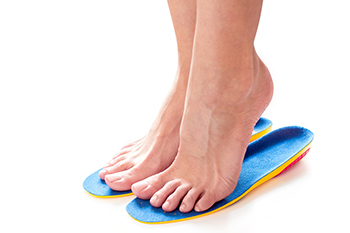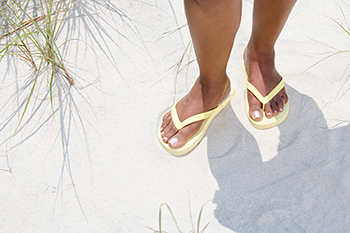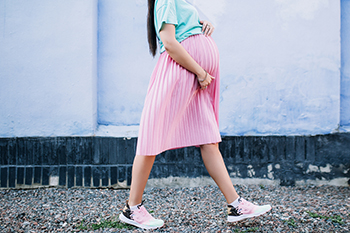Items filtered by date: June 2023
Dealing With Clubfoot in Babies

Clubfoot is a congenital foot defect that can be detected before birth, but usually is diagnosed after the baby is born. Soon thereafter, treatment can begin. A clubfoot, also called talipes, is characterized by the foot pointing down and inward with the sole facing backward. It can affect one or both feet, but is not painful for babies. A treatment called the Ponseti method is frequently the first step in correcting clubfoot. During this process, the baby’s foot is manipulated into the correct position and placed in a cast. The process is repeated frequently as the baby grows. After the cast is permanently removed, minor surgery may be required to loosen the Achilles tendon. After that, the baby will wear special boots to prevent the clubfoot from returning. These boots will be worn daily for three months, and then as the baby ages, the boots are worn at night until they are about five years old. Most babies respond well to this treatment, and begin to walk normally. For further information about clubfoot, it is suggested that you consult a podiatrist.
Congenital foot problems require immediate attention to avoid future complications. If you have any concerns, contact one of our podiatrists of William Street Podiatry. Our doctors can provide the care you need to keep you pain-free and on your feet.
Congenital foot problems are deformities affecting the feet, toes, and/or ankles that children are born with. Some of these conditions have a genetic cause while others just happen. Some specific foot ailments that children may be born with include clubfeet, polydactyly/macrodactyly, and cleft foot. There are several other foot anomalies that can occur congenitally. What all of these conditions have in common is that a child may experience difficulty walking or performing everyday activities, as well as trouble finding footwear that fits their foot deformity. Some of these conditions are more serious than others. Consulting with a podiatrist as early as possible will help in properly diagnosing a child’s foot condition while getting the necessary treatment underway.
What are Causes of Congenital Foot Problem?
A congenital foot problem is one that happens to a child at birth. These conditions can be caused by a genetic predisposition, developmental or positional abnormalities during gestation, or with no known cause.
What are Symptoms of Congenital Foot Problems?
Symptoms vary by the congenital condition. Symptoms may consist of the following:
- Clubfoot, where tendons are shortened, bones are shaped differently, and the Achilles tendon is tight, causing the foot to point in and down. It is also possible for the soles of the feet to face each other.
- Polydactyly, which usually consists of a nubbin or small lump of tissue without a bone, a toe that is partially formed but has no joints, or an extra toe.
- Vertical talus, where the talus bone forms in the wrong position causing other bones in the foot to line up improperly, the front of the foot to point up, and the bottom of the foot to stiffen, with no arch, and to curve out.
- Tarsal coalition, when there is an abnormal connection of two or more bones in the foot leading to severe, rigid flatfoot.
- Cleft foot, where there are missing toes, a V-shaped cleft, and other anatomical differences.
- Macrodactyly, when the toes are abnormally large due to overgrowth of the underlying bone or soft tissue.
Treatment and Prevention
While there is nothing one can do to prevent congenital foot problems, raising awareness and receiving neonatal screenings are important. Early detection by taking your child to a podiatrist leads to the best outcome possible.
If you have any questions please feel free to contact one of our offices located in William Street in New York, NY, Forest Hills, NY, and Broadway in New York, NY . We offer the newest diagnostic tools and technology to treat your foot and ankle needs.
Various Types of Orthotics

Orthotics are inserts that are put inside the shoes which can help to correct problematic foot structures. People who have flat feet, high arches, or foot conditions such as arthritis and plantar fasciitis may benefit from wearing orthotics. Soft, rigid, and semi-rigid are the different types of orthotics to choose from, and each kind is designed to provide the desired results for the specific foot condition. Soft orthotics may provide cushioning that can help to absorb shock, in addition to reducing pressure while walking. Plastic or graphite materials are used to make rigid orthotics, which and may help to improve alignment and movement. The most common types of orthotics are semi-rigid and are constructed with flexible materials that lie over a firm bottom layer. People who have diabetes may wear orthotics as a method of preventing sores or blisters from developing. If you would like to have more knowledge about orthotics, it is suggested that you confer with a podiatrist who can provide you with the information you are seeking.
If you are having discomfort in your feet and would like to try orthotics, contact one of our podiatrists from William Street Podiatry. Our doctors can provide the care you need to keep you pain-free and on your feet.
What Are Orthotics?
Orthotics are inserts you can place into your shoes to help with a variety of foot problems such as flat feet or foot pain. Orthotics provide relief and comfort for minor foot and heel pain but can’t correct serious biomechanical problems in your feet.
Over-the-Counter Inserts
Orthotics come in a wide variety of over-the-counter inserts that are used to treat foot pain, heel pain, and minor problems. For example, arch supports can be inserted into your shoes to help correct overarched or flat feet, while gel insoles are often used because they provide comfort and relief from foot and heel pain by alleviating pressure.
Prescription Orthotics
If over-the-counter inserts don’t work for you or if you have a more severe foot concern, it is possible to have your podiatrist prescribe custom orthotics. These high-quality inserts are designed to treat problems such as abnormal motion, plantar fasciitis, and severe forms of heel pain. They can even be used to help patients suffering from diabetes by treating foot ulcers and painful calluses and are usually molded to your feet individually, which allows them to provide full support and comfort.
If you are experiencing minor to severe foot or heel pain, it’s recommended to speak with your podiatrist about the possibilities of using orthotics. A podiatrist can determine which type of orthotic is right for you and allow you to take the first steps towards being pain-free.
If you have any questions please contact one of our offices located in William Street in New York, NY, Forest Hills, NY, and Broadway in New York, NY . We offer the newest diagnostic and treatment technologies for all your foot and ankle needs.
Do Your Child's Feet Hurt?
Pros and Cons of Wearing Flip Flops

Flip-flops are a simple shoe to wear and can be constructed with materials that range from neon foam to expensive leather. Despite their simplicity and array of various colors, research has shown they may not be a good choice of shoe to wear every day. This can be a result of having little or no support in the heel and arch area. Additionally, the toes may become cramped as they try to keep the shoe on the foot. It is beneficial for people who enjoy wearing flip-flops to limit the types of environments that are worn in. Ideal places to wear these types of shoes include the beach, swimming pools, and public showers. They are helpful in preventing conditions such as an athlete's foot from developing. It is recommended to avoid wearing them while driving, participating in sporting events, and walking long distances. If you would like more information about the pros and cons of wearing flip-flops, it is suggested that you confer with a podiatrist.
Flip-flops can cause a lot of problems for your feet. If you have any concerns about your feet or ankles, contact one of our podiatrists from William Street Podiatry. Our doctors will assist you with all of your foot and ankle needs.
Flip-Flops and Feet
Flip-flops have managed to become a summer essential for a lot of people. While the shoes may be stylish and easy to slip on and off, they can be dangerous to those who wear them too often. These shoes might protect you from fungal infections such as athlete’s foot, but they can also give you foot pain and sprained ankles if you trip while wearing them.
When Are They Okay to Wear?
Flip-flops should only be worn for very short periods of time. They can help protect your feet in places that are crawling with fungi, such as gym locker rooms. Athlete’s foot and plantar warts are two common fungi that flip-flops may help protect your feet against.
Why Are They Bad for My Feet?
These shoes do not offer any arch support, so they are not ideal for everyday use. They also do not provide shock absorption or heel cushioning which can be problematic for your feet. Additionally, you may suffer from glass cuts, puncture wounds, and stubbed toes since they offer little protection for your feet.
More Reasons Why They Are Bad for Your Feet
- They Slow You Down
- May Cause Blisters and Calluses
- Expose Your Feet to Bacteria
If you have any questions, please feel free to contact one of our offices located in William Street in New York, NY, Forest Hills, NY, and Broadway in New York, NY . We offer the newest diagnostic and treatment technologies for all your foot care needs.
Foot Conditions From Pregnancy

There are a multitude of changes that happen to the body during pregnancy. These can affect the feet, and many pregnant women find relief from resting and elevating their feet at various times during the day. A common condition during pregnancy is flat feet, which causes the arch to temporarily disappear as weight is gained. An effective remedy for flat feet during this time can include wearing shoes that fit correctly, and wearing custom-made orthotics. These types of insoles may be helpful in providing the support that is needed to relieve the pain from achy feet. Hormonal changes may cause the feet to have hot or burning sensations, possibly leading to an increase in body temperature. The majority of foot conditions during pregnancy may be managed by drinking plenty of water daily, keeping physically active, and wearing seamless socks, which may help poor circulation. It is suggested that women who have foot pain during pregnancy speak to a podiatrist who can offer effective relief remedies.
Pregnant women with swollen feet can be treated with a variety of different methods that are readily available. For more information about other cures for swollen feet during pregnancy, consult with one of our podiatrists from William Street Podiatry. Our doctors will attend to all of your foot and ankle needs.
What Foot Problems Can Arise During Pregnancy?
One problem that can occur is overpronation, which occurs when the arch of the foot flattens and tends to roll inward. This can cause pain and discomfort in your heels while you’re walking or even just standing up, trying to support your baby.
Another problem is edema, or swelling in the extremities. This often affects the feet during pregnancy but tends to occur in the later stages.
How Can I Keep My Feet Healthy During Pregnancy?
- Wearing orthotics can provide extra support for the feet and help distribute weight evenly
- Minimize the amount of time spent walking barefoot
- Wear shoes with good arch support
- Wear shoes that allow for good circulation to the feet
- Elevate feet if you experience swelling
- Massage your feet
- Get regular, light exercise, such as walking, to promote blood circulation to the feet
If you have any questions please feel free to contact one of our offices located in William Street in New York, NY, Forest Hills, NY, and Broadway in New York, NY . We offer the newest diagnostic and treatment technologies for all your foot and ankle needs.


